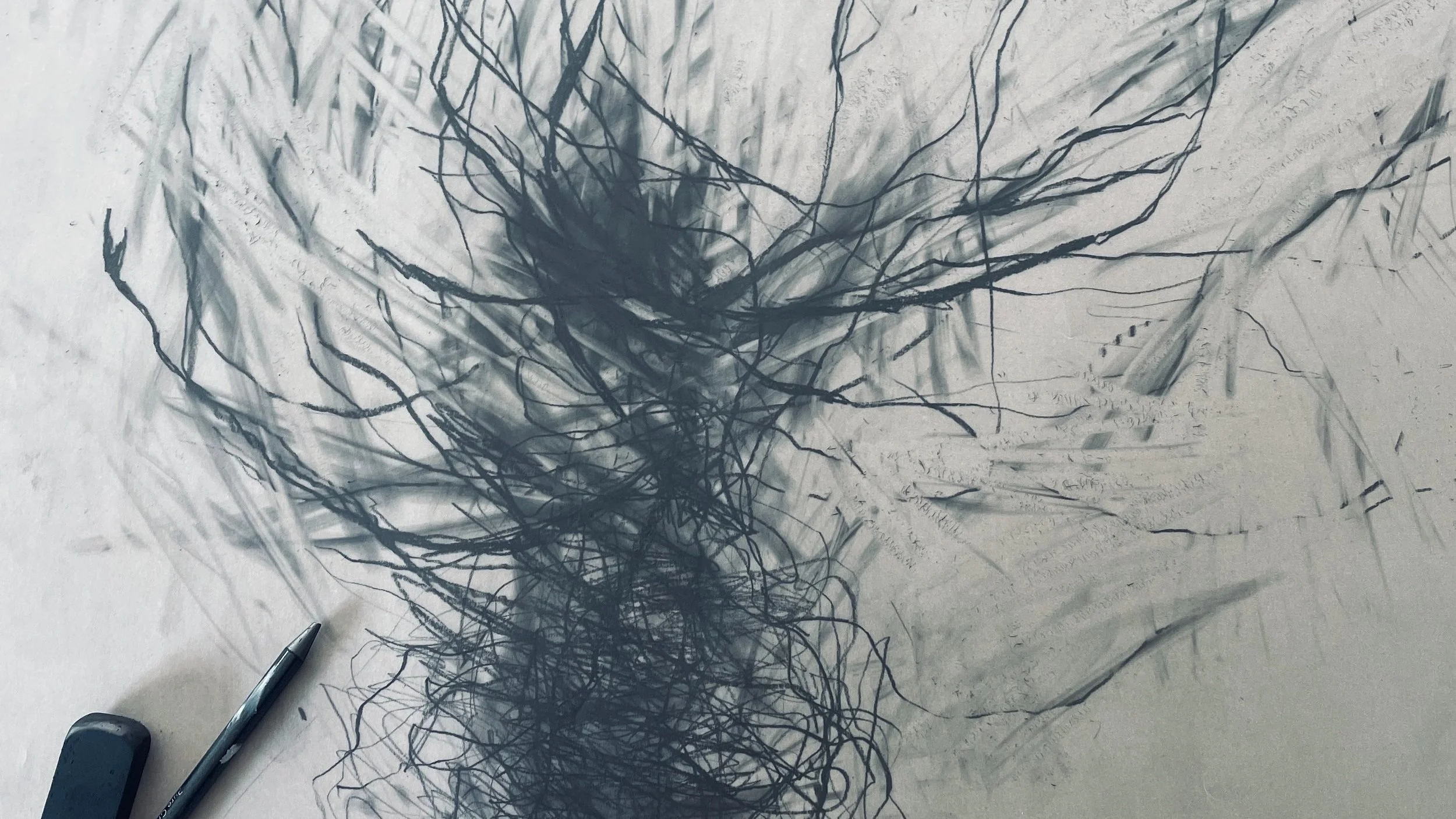Unit Three Assessment | 5 minute Video
Unit Three Video Text
1. Before the MA my work was painting and drawing of the landscape, which had begun to feel thin and self conscious. I wanted to see the Earth more expansively, unearthing unresolved feelings of personal and collective grief and move looking into understanding and participation. I have spent much of the past two years researching how the word ‘landscape’ no longer feels relevant to me, questioning the landscape as a ‘de facto’ image towards a gentler, fluid reciprocity, where I might create work that embodies a sense of mutuality with place. I began to interrogate Western histories of seeing landscapes along a trajectory of the picture plane from the viewpoint of passive, distanced human, separate from place; observing lines in the landscape not weaving through topographical elements but along political and agricultural boundaries that divide place into units for agronomic management in our relentless quest for economic growth. In this context, consuming images of beautiful places feels out of sync, unethical, with the climate challenges we face and I realised that painting the landscape as a static image was creating a barrier to understanding how place might shape my own life experiences, memories and futures. 1:08
2. My family and I bought a renovation project in Wiltshire two years ago and chain sawing up the neglected, ailing hedges and trees, creating huge piles of trimmings and arboreal remains, captured my interest and I started drawing the tangled piles of discarded branches, finding them more interesting than their living counterparts. Over time I watched their discarded limbs sink slowly back into the ground as decay set in, heating and rotting like a huge composting death pyre. The idea of our natural world as a memento mori has long captured my imagination and I return to our collective land as a shared tumulus in my work time and again. If there have been 117 billion humans to have walked our earth plus all the other-than-human, most are recollected only in the way that they form the dirt upon which those of us still breathing walk.1:53
My drawings made an intuitive leap where the picture plane made space instead for ‘inside’ the Earth imaginings, initially seeing the upended roots of trees as metaphors but then seeing them as portals into underground thinking where the critters reside, where networks of mycelium, tunnel diggers, worms and other mini-beasts dominate an ‘other’ realm. I began making drawings of and from my compost heap, which is itself the very definition of decay and renewal, as well as source material for observing networks and reciprocity of natural systems. 2:22
3. I then looked to the compost to explore materiality, making charcoal from branches, experimenting with paper making and casting from garden debris, liquid recycled paper and compost humus ink made from the Earthly goo that seeps out of the decaying, burning heap of spent organic rubble. I have been shredding, boiling and blending up kitchen waste with recycled paper and garden compost matter as a way of climbing inside the organic physicality of my surroundings to see what it is made of. I left the drawings outside to watch the decomposition process with help from the worms and crawlies. The liquid paper was then drawn into fragile networks of lace or drawn onto paper and eventually returned to the compost for the cycle to begin again.
3:03
4. The liquid paper drawings have moved into cast forms, morphing out of the picture plane and into spatially ambiguous floating drawings that memorialise beautiful, natural forms normally considered unworthy of grieving. Using beeswax and paper pulp I am beginning to understand reciprocity - the neither liquid nor solid forms of both that dance somewhere between presence and disappearance and re-presence creating mirror images and memories of one another until all that remains is an echo of the entanglement of two perfectly matched forms such that their separation becomes an illusion. This more expansive approach to drawing has meant I am exploring a continuousness of paper making and casting alongside drawn and sewn ‘lines’ and events within the paper; piled up assemblages of drawing fragments to suggest hungry edges, unfixed by time nor border; casting kitchen waste such as cabbage leaves into paper reflections on storytelling. They question edge-less-ness but also paper as more than a material but also a medium and concept, symbolic in its history of disseminating written knowledge and a sustainable resource from my own garden. Participation in an act of expanded drawing that expresses kinship between self and other through the wisdom of cellulose is emerging as an ecologically positive and artistically thrilling process.
4:22
5. My work is now coming full circle as I consider personal, collective and ecological grief, regarding drawing as an act of kindness, generous attention-giving in the phenomenon of the empathetic drawing encounter. Drawing as a quiet conversation between self and other is a ritual of compassion, a deep bow, a moment of grief for a clump of dead lavender, hives, mycelium networks, nests and cabbage leaves, making kin in the process, becoming the paper and the paper becoming me, all returned to the compost in the end. My work is about places that memorialise spent being, where we live and die as individuals but in death we return our borrowed molecules and residuum to the Earth where life continues its unabated cycles, extended kin, linked in unimaginable loops and tangles, made and found, belonging and forgotten. Our existence is so brief but our deaths go on forever.
05:11
